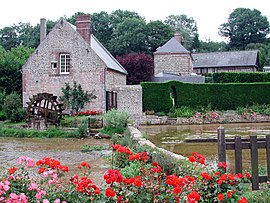Veules-les-Roses
Veules-les-Roses | |
|---|---|
 | |
| Country | France |
| Region | Normandy |
| Department | Seine-Maritime |
| Arrondissement | Dieppe |
| Canton | Saint-Valery-en-Caux |
| Intercommunality | Côte d'Albâtre |
| Government | |
| • Mayor (2008–2014) | Jean-Claude Claire |
| Area 1 | 5.19 km2 (2.00 sq mi) |
| Population (2006) | 601 |
| • Density | 120/km2 (300/sq mi) |
| Time zone | UTC+01:00 (CET) |
| • Summer (DST) | UTC+02:00 (CEST) |
| INSEE/Postal code | 76735 /76980 |
| Elevation | 0–79 m (0–259 ft) (avg. 12 m or 39 ft) |
| 1 French Land Register data, which excludes lakes, ponds, glaciers > 1 km2 (0.386 sq mi or 247 acres) and river estuaries. | |
Veules-les-Roses is a commune in the Seine-Maritime department in the Haute-Normandie region in northern France.
Geography
A tourism and farming village situated on the coast of the English Channel in the Pays de Caux, some 12 miles (19 km) southwest of Dieppe at the junction of the D68, D926 and the D142.
The river Veules, which flows through the commune, is the shortest sea-bound river of France at 1.194 kilometres (0.742 mi). Its water is used to create ponds for growing watercress whence it finds its way to the sea through a gap in the high chalk cliffs, which overlook a sand and pebble beach.
Population
| Year | 1962 | 1968 | 1975 | 1982 | 1990 | 1999 | 2006 |
|---|---|---|---|---|---|---|---|
| Population | 688 | 691 | 629 | 686 | 753 | 679 | 586 |
| From the year 1962 on: No double counting—residents of multiple communes (e.g. students and military personnel) are counted only once. | |||||||
Places of interest
- The church of St. Martin, dating from the thirteenth century.
- A house known as ‘The Old Château’ with a dovecote.
- A sixteenth century presbytery now the Hôtel des Tourelles.
- A monument to Victor Hugo.
- Three restored watermills.
- A seventeenth-century chapel.
- The ruins of the church of St. Nicolas and a sandstone Celtic cross, both dating from the sixteenth century.
- The twelfth-century chapel of Notre-Dame.
- The ship wreck of the Cérons. The ship sank the 12 June 1940 and is visible on the shore at low tide.[1]

People
Many artists have come here to paint, such as Anaïs Aubert, Étienne Mélingue, Henri Harpignies, Paul Meurice, Samuel Peploe and John Duncan Fergusson of the Scottish Colourists school, Ilya Repin and Alexey Bogolyubov of the Russian Peredvizhniki school. Writers include Leroux and Eugène Pierron, Alexandre Dumas fils, Lockroy, José-Maria de Heredia, Henri Rochefort, Alexis Bouvier, Jules Michelet and Victor Hugo, poets Jean Richepin and François Coppée, dramatists Jules Claretie, Henri Lavedan and Émile Bergerat and the composer Alexandre Georges. Politicians such as Henri Maret, Alexandre Millerand, René Viviani, Louis Malvy, Albert Clemenceau and Pierre Taittinger came here for the sea air. Victor Boucher, Georges Chamarat, Saint-Granier, the writer Maurice Privat, Dominique Bonnaud as well as sports personalities Suzanne Lenglen and Lucien Gaudin.
-
Prawn fishermen
-
The river Veules
-
Cross
-
Terrace of the Casino before the war
-
A party given by Victor Hugo to the children of Veules (24 September 1882)
-
Veules les Rose c. 1905 Samuel Peploe
-
British and French prisoners at Veules-les-Roses, France, June 1940.
-
View of the church
-
Sunset
See also
References
External links











